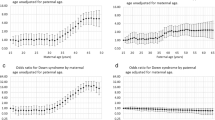Summary
This paper reanalyzes the data from the Hook and Cross (1982) paper in this journal concerning the association between Down's syndrome and paternal age. The New York State (NYS) data are compared with a large European collaborative study by Ferguson-Smith and Yates (1984). The maternal-age-dependent risks in the NYS data were found to be significantly higher than in the European data. When the NYS data was divided into three groups by means of the paternal age, a marked two-peaked distribution was found. The maternal-age-dependent risk was high when the fathers were up to 33 years old, low when the fathers' ages were 34–39 years and high again when the fathers were at least 40 years old. The differences were significant. The results speak in favour of the existence of temporal, geographic, or environmental variations in the risk for de novo trisomy 21, as well as of a paternal age effect. The existence of a “paternal age effect” in at least some populations is confirmed. If the results of this paper are confirmed in other investigations, it will be necessary to revise present genetic counselling rules towards far more individually specified considerations.
Similar content being viewed by others
References
Aymé S, Lippman-Hand A (1982) Maternal age effect in aneuploidy: does altered embryonic selection play a role? Am J Hum Genet 34:558–565
Gerguson-Smith MA, Yates JR (1984) Maternal age specific rates for chromosome aberrations and factors influencing them: report of a collaborative European study on 52965 amniocenteses. Prenat Diagn 4:5–44
Ford JH (1984) Spindle microtubular dysfunction in mothers of Down syndrome children. Hum Genet 68:295–298
Harlap S (1974) A time-series analysis of the incidence of Down's syndrome in West Jerusalem. Am J Epidemiol 99:210–217
Hassold T, Chiu D (1985) Maternal age specific rates of numerical chromosome abnormalities with special reference to trisomy. Hum Genet 70:11–17
Hook EB, Cross PK (1982) Paternal age and Down's syndrome genotypes diagnosed prenatally: no association in New York State data. Hum Genet 62:167–174
Jongbloet PH, Mulder AM, Hammers AS (1982) Seasonality of preovulatory non-disjunction and the aetiology of Down syndrome. A European collaborative study. Hum Genet 62:134–138
Kelterborn G (1983) Untersuchung zur Herkunft des überzähligen Chromosoms 21 bei mongoloiden Kindern (Freie Trisomie 21), deren Mütter bei der Geburt älter als 35 Jahre alt waren. Diplomarbeit, Institut für Anthropologie und Humangenetik, Universität München
Stene J (1981) Effect of advancing paternal age on the incidence of trisomy 21. In: Burgio GR, Fraccaro M, Tiepolo L, Wolf U (eds) Trisomy 21. International Symposium Convento delle Clarisse, Rapallo 1979. Springer, Berlin Heidelberg New York, p 257
Stene J, Stene E, Stengel-Rutkowski S, Murken J-D (1981) Paternal age and Down's syndrome data from prenatal diagnoses (DFG). Hum Genet 59:119–124
Author information
Authors and Affiliations
Rights and permissions
About this article
Cite this article
Stene, E., Stene, J. & Stengel-Rutkowski, S. A reanalysis of the New York State prenatal diagnosis data on Down's syndrome and paternal age effects. Hum Genet 77, 299–302 (1987). https://doi.org/10.1007/BF00291413
Received:
Issue Date:
DOI: https://doi.org/10.1007/BF00291413




